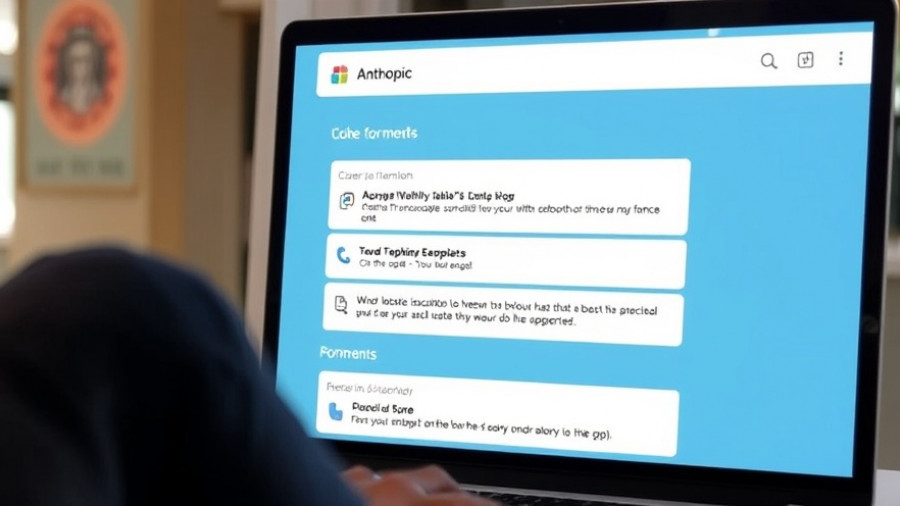
Claude Sonnet 4.5: Transforming Cybersecurity with Advanced AI
As various industries grapple with the ramifications of increasing cyber threats, artificial intelligence (AI) has emerged as a crucial ally in the fight against cybercrime. The latest developments from Anthropic, particularly with the Claude Sonnet 4.5 model, showcase a marked improvement in AI’s efficiency at identifying and mitigating software vulnerabilities. This transition represents a significant leap forward from theoretical applications of AI to practical, results-oriented uses in cybersecurity operations.
Performance Metrics Show Remarkable Improvement
Recent performance reports indicate that Claude Sonnet 4.5 has successfully increased the discovery rates of software vulnerabilities from 2% in its predecessor, Sonnet 4, to an impressive 5%. This leap is a critical step towards establishing a robust defense mechanism in cybersecurity. In competitive scenarios, Sonnet 4.5’s capacity to uncover new vulnerabilities surged, finding more than a third of vulnerabilities across multiple projects. These enhancements are not just incremental but reflect a deep integration of defensive capabilities into AI architectures, which were once primarily viewed as offensive tools.
Using AI for Defensive Strategies: A Paradigm Shift
The phenomenon of AI in both cybersecurity offense and defense emphasizes a dual-edged sword. On one hand, it has enabled malicious actors to automate and scale their operations; on the other hand, defenders are finally arming themselves with models like Claude Sonnet 4.5 that significantly level the playing field. It was noted during recent evaluations like the DARPA AI Cyber Challenge that utilizing such models in cyber reasoning systems led to the analysis of “millions of lines of code” to patch vulnerabilities effectively. This dual application of AI exemplifies a critical inflection point where ethical and strategic considerations must guide the deployment of such technologies.
Benchmarking Success: Cybench and CyberGym Evaluations
The results from crucial evaluations reinforce the model’s evolving credibility in real-world applications. In the Cybench evaluation, Claude Sonnet 4.5 achieved a remarkable 76.5% success rate when given ten attempts per challenge—a considerable rise from the 35.9% success rate of its predecessor. Similarly, in the CyberGym environment, Sonnet 4.5 not only performed better than prior models but set a new standard with a capability to reproduce vulnerabilities with a staggering 66.7% accuracy when given multiple attempts. This reflects a critical shift in how AI can be leveraged to detect both known and unknown vulnerabilities actively.
The Human Element: Industry Partnerships and Real-World Applications
The success of Claude Sonnet 4.5 draws attention not just to its technical prowess but also to the value placed on collaborating with industry partners. Companies like HackerOne and CrowdStrike have reported efficiencies that have drastically reduced vulnerability intake times and increased overall accuracy in threat detection. Real-world feedback has highlighted the model’s role in reducing risk for businesses and improving operational efficacy. These partnerships indicate a collaborative shift in cybersecurity efforts, diminishing the siloed nature of AI development.
Future Implications: Navigating the AI-Driven Cybersecurity Landscape
The moment we are in fosters an urgent call for vigilance and innovation in cybersecurity. As AI continues to evolve, the need to consider ethical implications and create resilient defenses will become increasingly paramount. The discussion surrounding emerging technologies like Claude Sonnet 4.5 unveils potential research avenues, such as automating cybersecurity review processes and further empowering security teams. However, amid these advancements, there lies an essential responsibility to ensure that AI is not solely a means for offense but stands as a robust line of defense for our digital infrastructure.
In summary, the advent of models like Claude Sonnet 4.5 represents a turning point in cybersecurity, turning AI into a formidable tool for defenders. As we adapt to this new landscape, embracing both AI’s defensive capabilities and its implications is crucial for maintaining our security integrity in the digital age.
 Add Row
Add Row  Add
Add 




Write A Comment